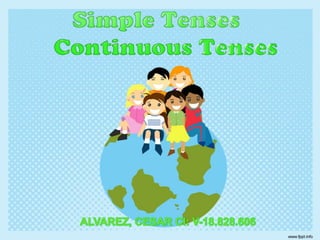
Simple and Continuous Tenses
- 2. The Present Simple tense is the most basic tense in English and uses the base form of the verb (except for the verb be). The only change from the base is the addition of s for third person singular. How do we make the Present Simple Tense? There are two basic structures for the Present Simple tense: 1. Positive sentences Subject + main verb Present Simple 2. Negative and question sentences Subject + auxiliary do + main verb conjugated in Present Simple do, does base
- 3. • I play baseball • She does not play baseball • Does he play baseball?
- 4. The Past Simple tense is sometimes called the "preterite tense". We can use several tenses and forms to talk about the past, but the Past Simple tense is the one we use most often. How do we make the Past Simple Tense? There are two basic structures for the Past Simple tense: 1. Positive sentences Subject + main verb Past Simple 2. Negative and question sentences Subject + auxiliary do + main verb conjugated in Past simple did base
- 5. • You called Peter. • Did you call Peter? • You did not call Peter.
- 6. The Future Simple tense is often called the "will" tense because we make the Future Simple with the modal auxiliary verb will. The structure of the Future Simple tense is: Subject + auxiliary will + main verb will base The auxiliary verb (will) is invariable: will The main verb is invariable in base form: base For negative sentences we insert not between the auxiliary verb and the main verb. For question sentences, we exchange the subject and the auxiliary verb.
- 7. • You will help him later. • Will you help him later? • You will not help him later.
- 8. We often use the Present Continuous tense in English. It is very different from the Present Simple tense, both in structure and in use. The structure of the Present Continuous tense is: Subject + auxiliary be + main verb conjugated in Present Simple am, are, is present participle The auxiliary verb (be) is conjugated in the Present Simple: am, are, is The main verb is invariable in present participle form: -ing For negative sentences we insert not between the auxiliary verb and the main verb. For question sentences, we exchange the subject and the auxiliary verb.
- 9. • You are watching TV. • Are you watching TV? • You are not watching TV.
- 10. The Past Continuous tense is an important tense in English. We use it to say what we were in the middle of doing at a particular moment in the past. The structure of the past continuous tense is: Subject + auxiliary be + main verb conjugated in Past Simple was, were present participle The auxiliary verb (be) is conjugated in the Past Simple: was, were The main verb is invariable in present participle form: -ing For negative sentences we insert not between the auxiliary verb and the main verb. For question sentences, we exchange the subject and the auxiliary verb.
- 11. • You were studying when she called. • Were you studying when she called? • You were not studying when she called.
- 12. The Future Continuous tense is often used in English as a way to talk about something happening at a given point in the future. The structure of the Future Continuous tense is: Subject + auxiliary will + auxiliary be + main verb will be present participle The first auxiliary verb (will) is invariable: will The second auxiliary verb (be) is invariable in base form: be The main verb is invariable in present participle form: -ing For negative sentences we insert not after the first auxiliary verb. For question sentences, we exchange the subject and the first auxiliary verb.
- 13. • will be waiting for her when her plane arrives tonight. • Will you be waiting for her when her plane arrives tonight? • You will not be waiting for her when her plane arrives tonight.